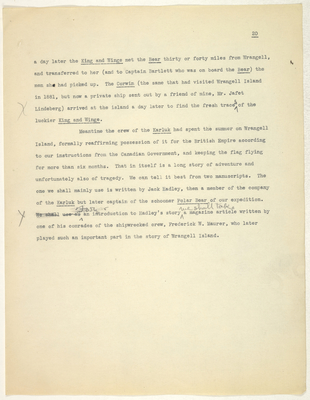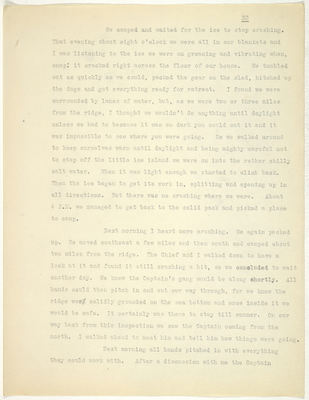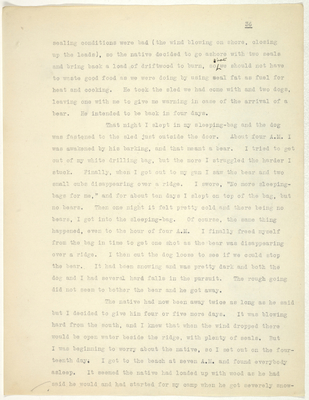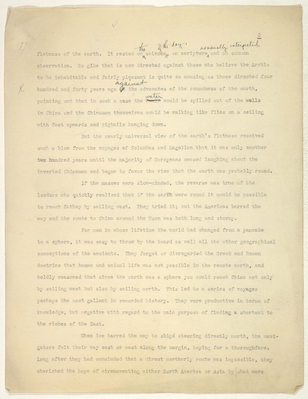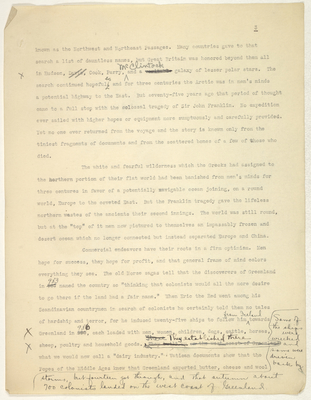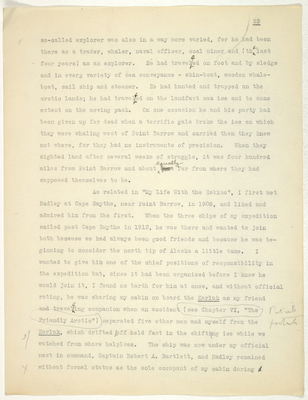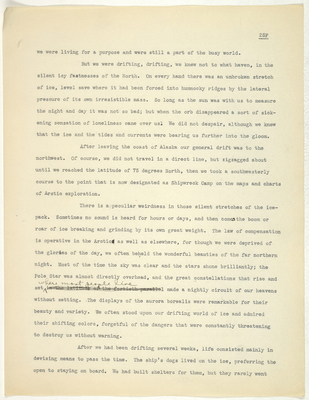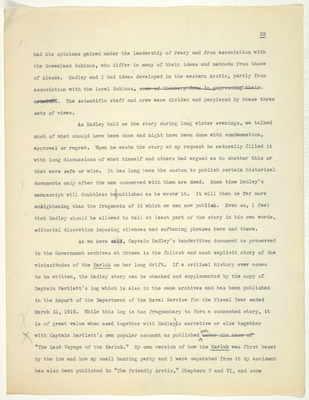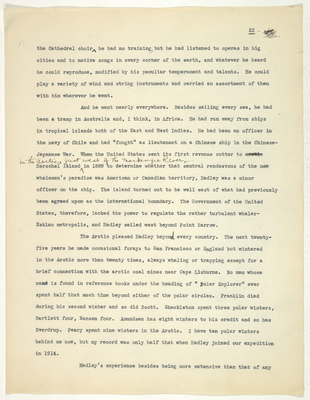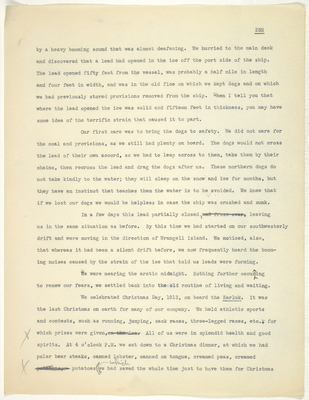Pages That Need Review
stefansson-wrangel-09-26-001
stefansson-wrangel-09-26-001-025
20
a day later the King and Winge met the Bear thirty or forty miles from Wrangell, and transferred to her (and to Captain Bartlett who was on board the Bear) the men she had picked up. The Corwin (the same that had visited Wrangell Island in 1881, but now a private ship sent out by a friend of mine, Mr. Jafet Lindeberg) arrived at the island a day later to find the fresh traces of the luckier King and Winge.
Meantime the crew of the Karluk had spent the summer on Wrangell Island, formally reaffirming possession of it for the British Empire according to our instructions from the Canadian Government, and keeping the flag flying for more than six months. That in itself is a long story of adventure and unfortunately also of tragedy. We can tell it best from two manuscripts. The one we shall mainly use is written by Jack Hadley, then a member of the company of the Karluk but later captain of the schooner Polar Bear of our expedition. We shall use as [For] an introduction to Hadley's story we shall take a magazine article written by one of his comrades of the shipwrecked crew, Frederick W. Maurer, who later played such an important part in the story of Wrangell Island.
stefansson-wrangel-09-26-001-048
33
We camped and waited for the ice to stop crushing. That evening about eight o’clock we were all in our blankets and I was listening to the ice we were on groaning and vibrating when, snap! it cracked right across the floor of our house. We tumbled out as quickly as we could, packed the gear on the sled, hitched up the dogs and got everything ready for retreat. I found we were surrounded by lanes of water, but, as we were two or three miles from the ridge, I thought we wouldn’t do anything until daylight unless we had to because it was so dark you could cut it and it was impossible to see where you were going. So we walked around to keep ourselves warm until daylight and being mighty careful not to step off the little ice island we were on into the rather chilly salt water. When it was light enough we started to climb back. Then the ice began to get its work in, splitting and opening up in all directions. But there was no crushing where we were. About 4 P.M. we managed to get back to the solid pack and picked a place to camp.
Next morning I heard more crushing. We again packed up. We moved southeast a few miles and then south and camped about two miles from the ridge. The Chief and I walked down to have a look at it and found it still crushing a bit, so we concluded to wait another day. We knew the Captain's gang would be along shortly. All hands could then pitch in and cut our way through, for we knew the ridge was solidly grounded on the sea bottom and once inside it we would be safe. It certainly was there to stay till summer. On our way back from this inspection we saw the Captain coming from the north. I walked ahead to meet him and tell him how things were going.
Next morning all hands pitched in with everything they could work with. After a discussion with me the Captain
stefansson-wrangel-09-26-001-051
36
sealing conditions were bad (the wind blowing on shore, closing up the leads), so the native decided to go ashore with two seals and bring back a load of driftwood to burn, so that we should not have to waste good food as we were doing by using seal fat as fuel for heat and cooking. He took the sled we had come with and two dogs, leaving one with me to give me warning in case of the arrival of a bear. He intended to be back in four days.
That night I slept in my sleeping-bag and the dog was fastened to the sled just outside the door. About four A.M. I was awakened by his barking, and that meant a bear. I tried to get out of my white drilling bag, but the more I struggled the harder I stuck. Finally, when I got out to my gun I saw the bear and two small cubs disappearing over a ridge. I swore, "No more sleepingbags for me," and for about ten days I slept on top of the bag, but no bears. Then one night it felt pretty cold and there being no bears, I got into the sleeping-bag. Of course, the same thing happened, even to the hour of four A.M. I finally freed myself from the bag in time to get one shot as the bear was disappearing over a ridge. I then cut the dog loose to see if we could stop the bear. It had been snowing and was pretty dark and both the dog and I had several hard falls in the pursuit. The rough going did not seem to bother the bear and he got away.
The native had now been away twice as long as he said but I decided to give him four or five more days. It was blowing hard from the south, and I knew that when the wind dropped there would be open water beside the ridge, with plenty of seals. But I was beginning to worry about the native, so I set out on the fourteenth day. I got to the beach at seven A.M. and found everybody asleep. It seemed the native had loaded up with wood as he had said he would and had started for my camp when he got severely snow-
stefansson-wrangel-09-26-001-006
flatness of the earth. It rested on the scienceof the day, on scripture as usually interpreted, and on common observation. No gibe that is now directed against those who believe the Arctic to be inhabitable and fairly pleasant is quite so amusing as those directed for hundred and forty years ago against the advocates of the roundness of the earth, pointing out that in such a case the wouldwater would be spilled out of the wells in Chine and the Chinamen themselves would be walking like flies on a ceiling with feet upwards and pigtails hanging fown.
But the nearly universal view of the earth's flatness received such a blow from the voyages of Columbus and Magellan that it was only another two hundred years until the majority of Europeans ceased laughing about the inverted Chinamen and began to favor the view that the earth was probably round.
If the masses were slow-minded, the reverse was trye of the leaders who quickly realized that if the earth were round it would be possible to reach Cathay by sailing west. They tried it; but the Americas barred the way and the route to China around the Horn was both long and stormy.
For men in whose lifetime the world had changed from a pancake to a sphere, it was easy to throw by the board as well all the other geographical conceptions of the ancients. They forgot or disregarded the Greek and Roman doctrine that human and animal life was not possible in the remote north, and boldly reasoned that since the earth was a sphere you could reach China not only by sailing west but also by sailing north. This led to a series of voyages perhaps the most gallant in recorded history. They were productive in terms of knowledge, but negative with regard to the main purpose of finding a shortcut to the riches of the East.
When ice barred the way to ships steering directly north, the navigators felt their way east or west along the margin, hoping for a thoroughfare. Long after they had concluded that a direct northerly route was impossible, they cherised the hope of circumeventing either North America or Asia by what were
stefansson-wrangel-09-26-001-007
3
known as the Northwest and Northeast passages. Many countries gave to that search a list of dauntless names, but Great Britain was honored beyond them all in Hudson, Davis, Cook, Parry, McClintockand a galaxy of lesser polar stars. The search continued gopefully and for three centuries the Arctic was in men's minds a potential highway to the East. But seventy-five years ago that period of thought came to a full stop with the colossal tragedy of Sir John Franklin. No expedition ever sailed with higher hopes or equipment more sumptuously and carefully provided. Yet no one ever returned from the voyage and the story is known only from the tiniest fragments of documents and from the scattered bones of a few of those who died.
The white and fearful wilderness which the Greeks had assigned to the northern portion of their flat world had been banished from men's minds for three centures in favor of a potentially navigable ocean joining, on a round world, Europe to the coveted East. But the Franklin tragedy gave the lifeless northern wastes of the ancients their second innings. The world ’was still round, but at the "top" of it men now pictured to themselves an impassably frozen and desert ocean which no longer connected but instead separated Europe and China.
Commercial endeavors have their roots in a firm optimism. Men hope for success, they hope for profit, and that general frame of mind colors everything they see. The old Norse sagas tell that the discoverers of Greenland in 987983named the country so "thinking that colonists would all the more desire to go there if the land had a fair name." Then Eric the Hed went among his Scandinavian countrymen in search of colonists he certainly told them no tales of hardship and terror, for he induced twenty-five ships to follow him from Icelandtowards Greenland in 986, each loaded with men, women, children, dogs, cattle, horses, sheep, poultry and household goods. They established there what we would now call a "dairy industry." Vatican documents show that the Popes of the Middle Ages knew that Greenland exported butter, cheese and wool some of the ships were wrecked and some were driven back by storms, but fourteen got throuhg and that autumn about 700 colonists landed on the west coast of Greenland.
stefansson-wrangel-09-26-001-028
23
so-called explorer was also in a way more varied, for he had been there as a trader, whaler, naval officer, coal miner and (the last four years) as an explorer. He had travelled on foot and by sledge and in every variety of sea conveyance - skin-boat, wooden whaleboat, sail ship and steamer. He had hunted and trapped on the arctic lands; he had travelled on the landfast sea ice and to some extent on the moving pack. On one occasion he and his party had been given up for dead when a terrific gale broke the ice on which they were whaling west of Point Barrow and carried them they knew not where, for they had no instruments of precision. When they sighted land after several weeks of struggle, it was four hundred miles from Point Barrow and about equally far from where they had supposed themselves to be.
As related in "My Life With the Eskimo", I first met Hadley at Cape Smythe, near Point Barrow, in 1908, and liked and admired him from the first. When the three ships of my expedition sailed past Cape Smythe in 1913, he was there and wanted to ioin both because we had always been good friends and because he was beginning to consider the north tip of Alaska a little tame. I wanted to give him one of the chief positions of responsibility in the expedition but, since it had been organized before I knew he would join it, I found no berth for him at once, and without official rating, he was sharing my cabin on board the Karluk as my friend and travelling companion when an accident (see Chapter VI, "the
Friendly Arctic”) separated five other men and myself from-the Karluk, which drifted off held fast in the shiftipg ice while we watched from shore helpless. The ship was now under my official next in command, Captain Robert A. Bartlett, and Hadley remained without formal status as the sole occupant of my cabin during a
stefansson-wrangel-09-26-001-036
25F
we were living for a purpose and were still a part of the busy world.
But we were drifting, drifting, we knew not to what haven, in the silent icy fastnesses of the North. On every hand there was an unbroken stretch of ice, level save where it had been forced into hummocky ridges by the lateral pressure of its own irresistible mass. So long as the sun was with us to measure the night and day it was not so bad; but when the orb disappeared a sort of sickening sensation of loneliness came over us. We did not despair, although we knew that the ice and the tides and currents were bearing us further into the gloom.
After leaving the coast of Alaska our general drift was to the northwest. Of course, we did not travel in a direct line, but zigzagged about until we reached the latitude of 75 degrees North, then we took a southwesterly course to the point that is now designated as Shipwreck Camp on the maps and charts of Arctic exploration.
There is a peculiar weirdness in those silent stretches of the icepack. Sometimes no sound is heard for hours or days, and then comes the boom or roar of ice breaking and grinding by its own great weight. The law of compensation is operative in the Arctic as well as elsewhere, for though we were deprived of the glories of the day, we often beheld the wonderful beauties of the far northern night. Most of the time the sky was clear and the stars shone brilliantly; the Pole Star was almost directly overhead, and the great constellations that rise and set where most people live made a nightly circuit of our heavens without setting. The displays of the aurora borealis were remarkable for their beauty and variety. We often stood upon our drifting world of ice and admired their shifting colors, forgetful of the dangers that were constantly threatening to destroy us without warning.
After we had been drifting several weeks, life consisted mainly in devising means to pass the time. The ship's dogs lived on the ice, preferring the open to staying on board. We had built shelters for them, but they rarely went
stefansson-wrangel-09-26-001-030
25A
had his opinions gained under the leadership of Peary and from association with the Greenland Eskimos, who differ in many of their ideas and methods from those of Alaska. Hadley and I had ideas developed in the western Arctic, partly from association with the local Eskimos, some of themvery free in expressing their opinions. The scientific staff and crew were divided and perplexed by these three sets of views.
As Hadley told me the story during long winter evenings, we talked much of what should have been done and might have been done with condemnation, approval or regret. When he wrote the story at my request he naturally filled it with long discussions of what himself and others had argued as to whether this or that were safe or wise. It has long been the custom to publish certain historical documents only after the men concerned with them are dead. Some time Hadley’s manuscript will doubtless be published as he wrote it. It will then be far more enlightening than the fragments of it which we can now publish. Even so, I feel that Hadley should be allowed to tell at least part of the story in his own words, editorial discretion imposing silences and softening phrases here and there.
As we have said, Captain Hadley’s handwritten document as preserved in the Government archives at Ottawa is the fullest and most explicit story of the vicissitudes of the Karluk on her long drift. If a critical history ever comes . to be written, the Hadley story can be checked and supplemented by the copy of Captain Bartlett's log which is also in the same archives and has been published in the Report of the Department of the Naval Service for the Fiscal Year ended . While this log is too fragmentary to form a connected story, it is of great value when used together with Hadley's narrative or else together with Captain Bartlett s own popular account as published in under the name of "The Last Voyage of the Karluk.” My own version of how the Karluk was first beset by the ice and how my small hunting party and I were separated from it by accident has also been published in "The Friendly Arctic," Chapters V and VI, and some
stefansson-wrangel-09-26-001-027
22
the Cathedral choir he had no training, but he had listened to operas in big cities and to native songs in every corner of the earth, and whatever he heard he could reproduce, modified by his peculiar temperament and talents. He could play a variety of wind and string instruments and carried an assortment of them with him wherever he went.
And he went nearly everywhere. Besides sailing every sea, he had been a tramp in Australia and, I think, in Africa. He had run away from ships in tropical islands both of the East and West Indies. He had been an officer in the navy of Chile and had “fought” as lieutenant on a Chinese ship in the ChineseJapanese War. When the United States sent its first revenue cutter to arctic Herschel Island in the arctic just west of the mackenzie River in 1889 to determine whether that central rendezvous of the new whalemen's paradise was American or Canadian territory, Hadley was a minor officer on the ship. The island turned out to be well east of what had previously been agreed upon as the international boundary. The Government of the United States, therefore, lacked the power to regulate the rather turbulent whalerEskimo metropolis, and Hadley sailed west beyond Point Barrow.
The Arctic pleased Hadley beyond every country. The next twentyfive years he made occasional forays to San Francisco or England but wintered in the Arctic more than twenty times, always whaling or trapping except for a brief connection with the arctic coal mines near Cape Lisburne. No man whose namd is found in reference books under the heading of "Polar Explorer" ever spent half that much time beyond either of the polar circles. Franklin died during his second winter and so did Scott. Shackleton spent three polar winters, Bartlett four, Nansen four. Amundsen has eight winters to his credit and so has Sverdrup. Peary spent nine winters in the Arctic. I have ten polar winters behind me now, but my record was only half that when Hadley joined our expedition in 1914.
Hadley's experience besides being more extensive than that of any
stefansson-wrangel-09-26-001-038
25H
by a heavy booming sound that was almost deafening. We hurried to the main deck and discovered that a lead had opened in the ice off the port side of the ship. The lead opened fifty feet from the vessel, was probably a half mile in length and four feet in width, and was in the old floe on which we kept dogs and on which we had previously stored provisions removed from the ship. Wen I tell you that where the lead opened the ice was solid and fifteen feet in thickness, you may have some idea of the terrific strain that caused it to part.
Our first care was to bring the dogs to safety. We did not care for the coal and provisions, as we still had plenty on board. The dogs would not cross the lead of their own accord, so we had to leap across to them, take them by their chains, then recross the lead and drag the dogs after us. These northern dogs do not take kindly to the water; they will sleep on the snow and ice for months, but they have an instinct that teaches them the water is to be avoided. We knew that if we lost our dogs we would be helpless in case the ship was crushed and sunk.
In a few days this lead partially closed, and froze over, leaving us in the same situation as before. By this time we had started on our southwesterly drift and were moving in the direction of Wrangell Island. We noticed, also, that whereas it had been a silent drift before, we now frequently heard the booming noises caused by the strain of the ice that told us leads were forming.
We were nearing the arctic midnight. Nothing further occuring to renew our fears, we settled back into theebid routine of living and waiting.
We celebrated Christmas Day, 1913, on board the Karluk. It was the last Christmas on earth for many of our company. Wr held athletic sports and contests, such as running, jumping, sack races, three-legged races, etc., for which prizes were given, on the ice. All of us were in splendid health and good spirits. At 4 o'clock P.M. we sat down to a Christmas dinner, at which we had polar bear steaks, canned lobster, canned ox tongue, creamed peas, creamed [yWwfltf ]potatoes which we had saved the whole time just to have them for Christmas
